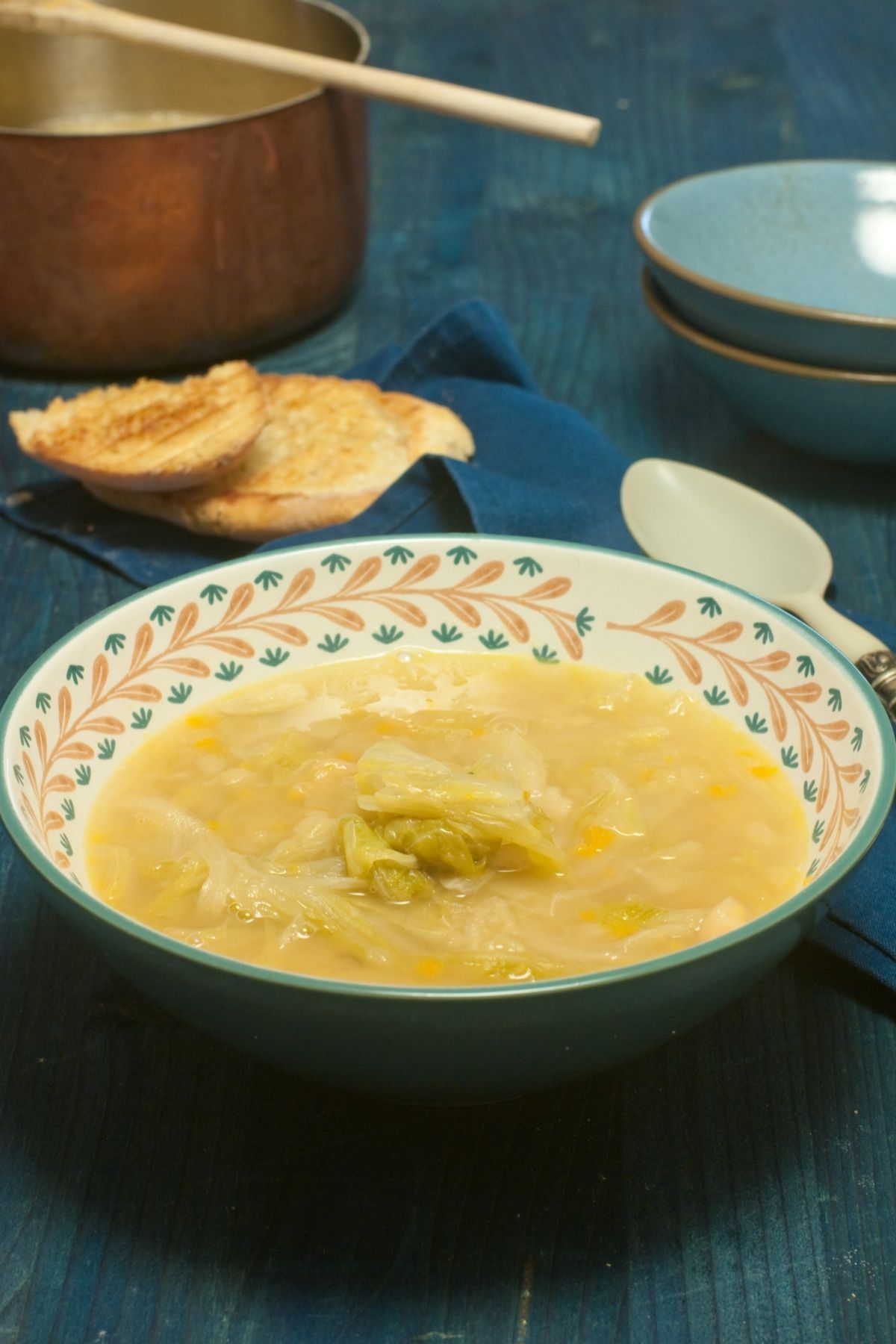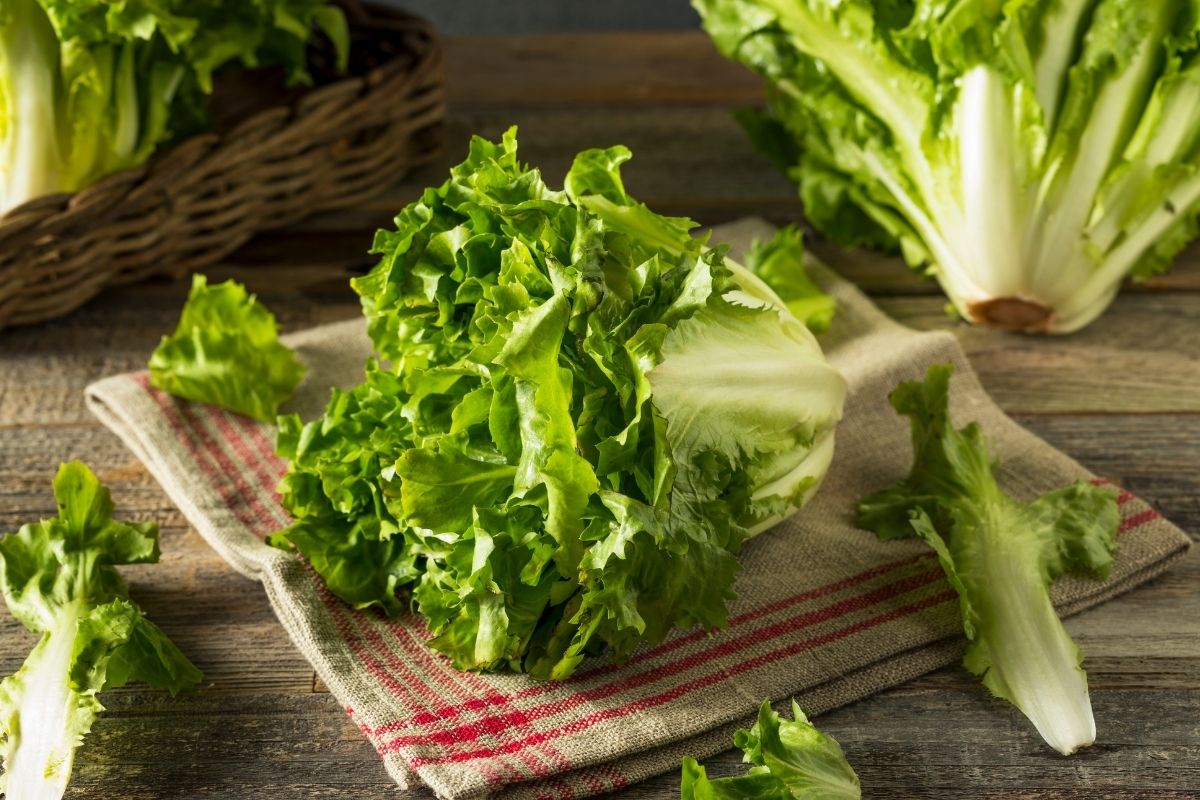What is Escarole Soup?
If you’re Italian, chances are you love a good bowl of escarole soup that you prepare using the best recipe for escarole soup. And if you’re not Italian, you should give it a try – this soup is full of flavor! This post will explain what escarole is and show you how to make a delicious bowl of escarole soup at home. So get ready to cozy up with a warm bowl of this classic comfort food!
How to Clean Escarole
If you’re looking for hearty, leafy greens to add to your soup or salad, escarole is an excellent option. But before you can enjoy this vegetable, you’ll need to clean it. Here’s how:
- Start by trimming off the bottom of the escarole head.
- Cut the head in half from top to bottom, then slice it into thin strips.
- Next, rinse the escarole under cold water, removing any dirt or debris.
- Finally, spin the escarole in a salad spinner or pat it dry with paper towels.
- You’re now ready to use your escarole in soups, salads, or any other dish you desire! Escarole can be bitter, so if you’re using it in a salad, you may want to pair it with a sweet dressing. If you’re adding escarole to soup, cook it for a few minutes first to help soften the leaves.

Why Does my Escarole Taste Bitter?
It’s called escarole soup because it traditionally contains escarole, a type of endive. The escarole gives the soup a slightly bitter flavor, offset by the sweetness of the other ingredients, like onions, carrots, and celery. You can also find versions of escarole soup that contain meat or pasta. If your escarole soup tastes bitter, there are a few possible reasons.
The first is that the escarole may be slightly bitter. This is due to compounds in the plant. If your soup is too bitter, you can try blanching the escarole in boiling water for two minutes before adding it to the soup pot. This will reduce some bitterness.
Another possibility is that your soup contains other ingredients contributing to the bitterness. Common culprits include onions, garlic, and certain types of spices. If you suspect that one of these ingredients is responsible for the bitter taste, you can try removing it from the recipe or using a less-intense variety.
For example, you might use mild onions instead of pungent onions or swap out garlic powder for fresh garlic cloves.
Finally, it’s possible that your soup needs a little bit more seasoning to balance out the bitterness. Try adding a touch of sweetness with honey or sugar or a splash of acidity with lemon juice or vinegar. A bit of salt can also help to round out the flavors and make the soup more palatable. Taste your soup as you go and adjust the seasonings until it tastes good to you.
How Can I Make my Escarole Soup Vegetarian?
If you’re looking to make your chicken escarole soup vegetarian, you can do a few things. First, you’ll need to swap out the chicken stock for vegetable stock or broth. You can also add extra vegetables like mushrooms, carrots, or celery to give the soup more body and flavor.
Finally, be sure to use a good quality olive oil, as this will elevate the flavors of the soup. With these simple tips, you’ll be able to easily create a delicious vegetarian Italian escarole soup that everyone will love.

A Brief History of Escarole
Geography/History
True endives, such as escarole, are said to have their origin in Sicily and the surrounding Mediterranean region. Since at least the 1500s, it has been commonly under cultivation in the United Kingdom. We can trace Its use as a salad back to ancient Greece, Rome, and Egypt, where it was popular.
There are references to it in ancient Roman records by Pliny the Elder and the poet Ovid. When we compare it to the narrow-leaved endive, the wide-leaved escarole is a more ancient variety of the family. Endive is now primarily growing in France, Italy, the Netherlands, Spain, and the United States. It was first under cultivation in China.
In Roman times, escarole was a delicacy, with many people serving it at banquets and feasts. Likewise, it is popular in Italian cuisine, and you can find it in many traditional dishes such as minestrone and Caesar salad.
While escarole is available year-round, it is best to eat it in the winter when it is in season. When buying escarole, look for leaves that are crisp and free of brown spots—store escarole in a plastic bag in the refrigerator and use it within one week.
Description/Taste
Escarole has broad, slightly curly, pale green leaves with a nutty, bitter taste similar to curly endive but with a less bitter bite. The thick, black outer leaves have a more bitter flavor than the lighter interior leaves, which are lighter in color.
You can partially tame escarole’s harsh flavor by cooking it, however. Escarole has a crunchy, crisp texture and retains its shape even after being cooked for several minutes.
Seasons/Availability
Escarole is accessible throughout the year, with a peak season occurring throughout the spring and summer.
Facts of the Present
Many know escarole botanically as Cichorium endivia. It is a member of the Cichorium genus and is in the category of flowering plants. Cichorium endivia is a species that encompasses all of the numerous kinds of curly endive and broad-leaved escarole that are grown in North America.
You will realize that people call “genuine” endive escarole the names Batavian, Bavarian, and Broad-leaved endive, all of which refer to the same plant.
Nutritional Benefits
Italian Escarole soup is a hearty and flavorful soup perfect for a cold winter day. You can make this soup with escarole, potatoes, carrots, and cannellini beans. It is a filling and satisfying meal that is also vegan and gluten-free. This recipe for escarole soup is simple to make, and you can quickly adapt it to suit your taste. For example, if you prefer a less bitter soup, you can blanch the escarole.
Escarole contains a high concentration of vitamin A, which you can demonstrate in tests to reduce the incidence of osteoporosis and cancer. It also includes a significant amount of vitamin K, which helps the body coagulate (clot) blood.
In addition, it includes considerable amounts of folate, vitamin C, dietary fiber, calcium, potassium, iron, and antioxidants like flavonoids and lutein, to name a few of the nutrients.
Applications
It is somewhat bitter and lends texture to both cooking and raw meals. Escarole is a member of the cabbage family. You can blend it with other greens and use it in salad recipes if you chop it finely. These salad greens are strong enough to withstand creamy or warm dressings and serve as a salad bed for your meat when you grill it.
You can also add fresh escarole leaves to sandwiches or use them in place of bread to make a wrap. After cooking, you can sauté, braise, stir-fry, or add the vegetable to soups and stews.
Salty meats such as bacon, sausage, and prosciutto pair well together in escarole soup with ingredients like white beans, apples, dates, citrus, shallots, fried garlic, avocado, cream-based sauces, extra-virgin olive oil, toasted nuts, dried cranberries, and hard cheeses such as blue, feta, and pecorino. You can store escarole in the refrigerator for up to a week.
Information on Ethnic/Cultural Groups
A distinctive element in the Italian American holiday soup known as “Straciatella,” escarole, is a traditional ingredient in the soup. “Straccia” is an Italian word that translates to “rags,” People commonly consume it around the holidays, New Year’s Eve, and sometimes during Easter.
It gets its name from the raggedy appearance of the threads of egg and escarole that float in the broth during the preparation. It is also a popular element in Italian wedding soup, known as “minestra maritata,” which translates as “married soup,” referring to how the soup’s meat and greens complement one another.
Preparation
If you’re looking for a hearty dish to warm you up on a cold day, look no further than escarole soup! This delicious soup usually contains beef or chicken broth, beans, tomatoes, and pasta. You can also make vegetarian escarole soup by substituting vegetable broth and omitting the meat. No matter how you make it, escarole soup will hit the spot!
You can eat escarole greens raw or cook them the same way as other bitter greens. It goes nicely with salty flavors like capers and anchovies and cured meats and fish. The popular escarole recipe is the Italian New Year’s Day soup stracciatella, which blends escarole leaves and an egg that you swirl into hot chicken stock.
It’s also good when you slow-braise it with beans stew, pesto, or meatballs. If you want to add a bit of bitterness to your cooking, then escarole is an excellent option. You can use It in various dishes, and it is trendy in soups. Escarole soup is a traditional Italian dish perfect for a chilly day.
Cooking
Blanch whole escarole leaves for two minutes in boiling water with salt, then remove and cool. Allow to drain and cool before stuffing each leaf with sauteed black olives, capers, pine nuts, and raisins.
Sprinkle toast bread crumbs and Parmesan cheese over the olive mixture, then roll the leaves like a burrito from the bottom to the tip. On a baking sheet, arrange the escarole leaves, top with extra bread crumbs and cheese, cover with foil, and bake until the toppings are golden brown.
If you find escarole too bitter, adding a sweetener (honey or dried fruit) to your Italian escarole soup recipe will help balance the flavor.
A Recipe for Escarole Soup (With Beans)
Level: Easy
Total: 22 min
Prep: 12 min
Cook: 10 min
Yield: 6 servings
Ingredients
- Cannellini beans, 1 can
- 4 cups low-salt chicken broth
- Freshly ground black pepper.
- 2 tablespoons olive oil
- 2 garlic cloves, chopped
- 1 pound escarole, chopped
- Salt
- 1 oz (28g) Parmesan
- 6 teaspoons extra-virgin olive oil
- Serving suggestion: crusty bread
Directions
- Heat two tablespoons of olive oil in a big heavy pot over medium heat.
- Sauté the garlic for about 15 seconds, or until fragrant.
- Add the escarole and cook for two minutes, or until it wilts.
- Season with a pinch of salt.
- Combine the chicken broth, beans, and Parmesan cheese in a mixing bowl.
- Cook for five minutes, or until the beans are hot enough; season with salt and pepper to taste.
- Divide the soup among six bowls. Drizzle one teaspoon of extra-virgin olive oil over each.
- Serve.
Nutrition Information
- Calories: 421kcal (21%)
- Carbohydrates: 58g (19%)
- Protein: 18g (36%)
- Fat: 13g (20%)
- Saturated Fat: 3g (19%)
- Cholesterol: 12mg (4%)
- Sodium: 487mg (21%)
- Potassium: 784mg (22%)
- Fiber: 6g (25%)
- Sugar: 7g (8%)
- Vitamin A: 2513IU (50%)
- Vitamin C: 12mg (15%)
- Calcium: 172mg (17%)
- Iron: 2mg (11%)

Channel Your Inner Italian!
So, if you are a vegetarian or not, we highly recommend that you try our escarole bean soup recipe. It will help you learn how to cook escarole in soup. It is healthy and delicious, but people from all walks of life can also enjoy it. There are many different recipes for escarole soup that you can experiment with to find your favorite variation.
We believe that this particular soup is the best one out there, and we hope you will give it a try soon!

Community of passionate writers and content creators who share a love for Italian heritage, culture, travel, food, and the Italian-American community. Our mission is to celebrate Italy’s rich history and traditions and connect with others who share the same passion.

